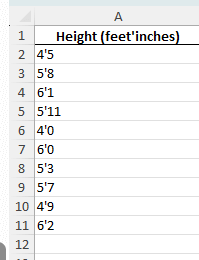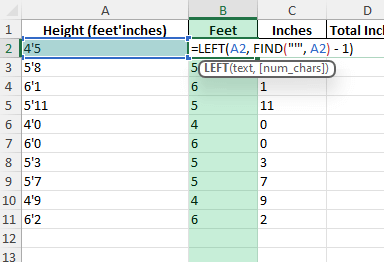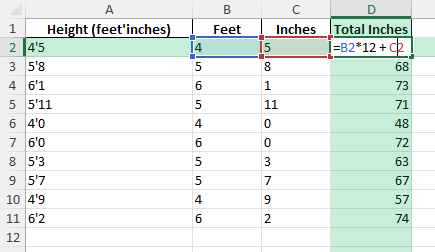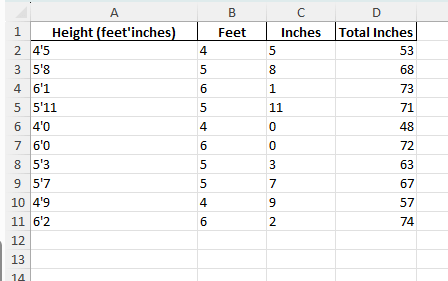If you ever need to convert heights written as 4’5 Feet to Inches in Excel, you are not alone. This is a common scenario in sports, medical records, fitness tracking, or any context where you receive height measurements in feet and inches and need a total in inches. Manual conversion can be slow and prone to errors, but with the right Excel formulas, you can automate this calculation for single entries or large lists. This guide will show you how to convert entries like 4’5 into inches efficiently, with step-by-step instructions, helpful tips, and an example workbook you can download.
Key Takeaways
- Quickly convert heights like 4’5 into total inches using Excel formulas.
- Learn to extract feet and inches from a text entry with formulas.
- Automate the conversion for long lists without manual math.
- Explore advanced methods using Power Query or VBA for batch conversion.
- Download a ready-to-use Excel workbook with formulas and sample data.
Table of Contents
Why Convert Feet and Inches to Total Inches?
Many datasets use the feet and inches format (for example, 5’10) because it is familiar and readable. However, calculations like average height, sorting, or comparison often require a single value. Converting the measurement to total inches simplifies these tasks and makes your data ready for analysis.
Understanding the Need for Conversion
In many fields, especially those involving design or construction, measurements often need to be converted to a single unit for calculations. Converting feet and inches into inches in Excel allows for streamlined data processing and reduces the possibility of errors in projects that require precise measurements. This conversion also facilitates easier data comparisons, integrations, and applications, such as financial analysis or inventory management.
Practical Applications and Benefits
Converting measurements to inches in Excel offers numerous practical benefits across various professional settings. For engineers, architects, and designers, it ensures that all calculations are performed using uniform units, increasing the accuracy and reliability of designs and blueprints. It also allows for consistent data analysis, vital in logistics and inventory management, where precise dimensions are necessary for storage and shipping calculations.
In addition, this conversion simplifies data validation processes by minimizing errors associated with unit conversion inconsistencies. For educators and students, learning and using these conversions in Excel enhances both data manipulation skills and familiarity with the software, which is vital in many careers.
Step-by-Step: Convert 4’5 Feet to Inches in Excel
Below is a step-by-step walkthrough of converting a height from the format 4’5 (text) into a total number of inches.
Step 1 – Prepare Your Data
List your heights in feet and inches format in column A, starting from cell A2 (e.g., 4’5, 5’8, 6’1, etc.).
Step 2 – Extract the Feet
In cell B2, use this formula to get the feet part:
=LEFT(A2, FIND("'", A2) - 1)
Step 3 – Extract the Inches
In cell C2, use this formula to get the inches part:
=MID(A2, FIND("'", A2) + 1, LEN(A2) - FIND("'", A2))
Step 4 – Calculate Total Inches
In cell D2, use this formula to get the total inches:
=B2*12 + C2
Copy this formula down for all your rows. Now, 4’5 (in A2) will give you 53 inches in D2.
Common Mistakes and How to Avoid Them
Missing the apostrophe: Double-check that your entries use the correct ' character between feet and inches. Typos can cause the formula to return errors.
Extra spaces or non-standard formats: Entries like 4' 5 (with a space) or 4ft5in require formula adjustments. Clean your data for consistency.
Text not recognized as numbers: If calculations do not work, use VALUE() around your extraction formulas to force a numeric result.
Empty cells or invalid data: Add IFERROR() to your formulas to handle errors gracefully, e.g.,
=IFERROR(VALUE(LEFT(A2, FIND("'", A2) - 1))*12 + VALUE(MID(A2, FIND("'", A2) + 1, LEN(A2) - FIND("'", A2))), "")
Bonus Tips and Advanced Scenarios
Batch Conversion with Power Query: Power Query can split the feet and inches columns and handle thousands of rows with ease. Use Split Column by Delimiter at the apostrophe.
Handling Mixed Formats: For data with inconsistent separators (like 4-5 or 4 ft 5), use SUBSTITUTE() to standardize before extracting values.
Automating with VBA: You can use a VBA function to convert any height string to inches:
Function HeightToInches(cell As Range) As Double
Dim parts() As String
parts = Split(cell.Value, "'")
HeightToInches = Val(parts(0)) * 12 + Val(parts(1))
End Function
Paste this function into a module and use =HeightToInches(A2) in your worksheet.
Bringing It All Together: Practical Examples
Worked Example: 4’5″ to Inches
Converting 4’5″ to inches in Excel is a straightforward process that enhances your ability to handle measurement data effectively. Let’s break down the steps to perform this conversion:
- Feet to Inches: (4 \times 12 = 48)
- Adding the Inches: (48 + 5 = 53)
- Enter the data in one cell, say A1, as
4.05to signify 4 feet and 5 inches. - Use this formula:
=INT(A1)*12 + (A1-INT(A1))*100. This converts the measurement to a total of 53 inches.
The formula calculates the whole number of feet, converts it to inches, and then adds the remaining inches.
This approach provides a clear and precise conversion for Excel users dealing with similar measurements in their datasets, ensuring data accuracy across applications.
Real World Scenarios
In real-world scenarios, converting feet and inches into inches using Excel is invaluable across a multitude of industries. For instance, in construction, architects often need to provide contractors with dimension details in a single unit to avoid confusion on site. This ensures all building components fit together precisely as designed.
In the retail industry, particularly for companies dealing with furniture or home goods, products often listed in feet and inches must be converted to inches for inventory databases. This conversion facilitates easy matching with shipping constraints and warehouse management systems.
Another example is in the academic field, where researchers conducting anthropometric studies might collect data in feet and inches but require subsequent analysis in inches for standardization across studies.
These examples highlight the importance of using Excel’s conversion capabilities to enhance accuracy and efficiency in varied professional contexts.
FAQ: Converting 4’5 Feet to Inches in Excel
How does the formula handle heights with two-digit inches (like 5’11)?
The formulas extract everything after the apostrophe for inches, so they work with one or two digits. Just ensure your data format is consistent.
What if my data uses 4 ft 5 in instead of 4’5?
Use SUBSTITUTE() to convert “ft” and “in” to standard separators, or split using Text to Columns.
Can I use these formulas for batch conversion?
Yes, just drag the formula down for your full list, or use Power Query or VBA for even faster processing.
What happens with empty cells or typos?
Add IFERROR() to handle errors gracefully and keep your worksheet tidy.
Is there a quick way to reverse the process (inches to feet and inches)?
Yes. Use =INT(A2/12)&"'"&MOD(A2,12) if A2 is total inches.
John Michaloudis is a former accountant and finance analyst at General Electric, a Microsoft MVP since 2020, an Amazon #1 bestselling author of 4 Microsoft Excel books and teacher of Microsoft Excel & Office over at his flagship MyExcelOnline Academy Online Course.












